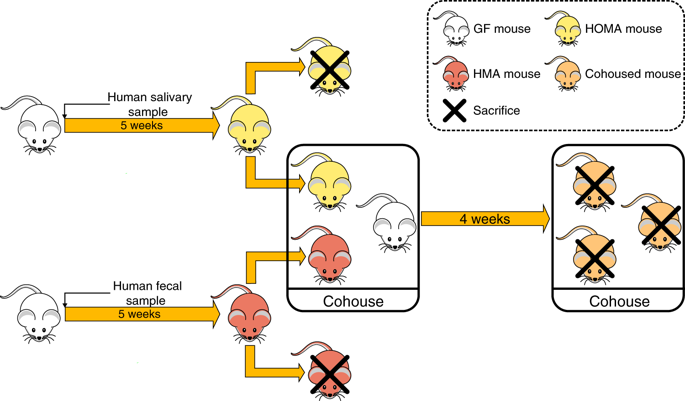当前位置:
X-MOL 学术
›
Int. J. Oral Sci.
›
论文详情
Our official English website, www.x-mol.net, welcomes your
feedback! (Note: you will need to create a separate account there.)
Oral bacteria colonize and compete with gut microbiota in gnotobiotic mice.
International Journal of Oral Science ( IF 10.8 ) Pub Date : 2019-03-05 , DOI: 10.1038/s41368-018-0043-9 Bolei Li 1, 2 , Yang Ge 1, 2 , Lei Cheng 1, 2 , Benhua Zeng 3 , Jinzhao Yu 1, 2 , Xian Peng 1 , Jianhua Zhao 4 , Wenxia Li 3 , Biao Ren 1 , Mingyun Li 1 , Hong Wei 3 , Xuedong Zhou 1, 2
International Journal of Oral Science ( IF 10.8 ) Pub Date : 2019-03-05 , DOI: 10.1038/s41368-018-0043-9 Bolei Li 1, 2 , Yang Ge 1, 2 , Lei Cheng 1, 2 , Benhua Zeng 3 , Jinzhao Yu 1, 2 , Xian Peng 1 , Jianhua Zhao 4 , Wenxia Li 3 , Biao Ren 1 , Mingyun Li 1 , Hong Wei 3 , Xuedong Zhou 1, 2
Affiliation

|
The oral microbiota is associated with oral diseases and digestive systemic diseases. Nevertheless, the causal relationship between them has not been completely elucidated, and colonisation of the gut by oral bacteria is not clear due to the limitations of existing research models. The aim of this study was to develop a human oral microbiota-associated (HOMA) mouse model and to investigate the ecological invasion into the gut. By transplanting human saliva into germ-free (GF) mice, a HOMA mouse model was first constructed. 16S rRNA gene sequencing was used to reveal the biogeography of oral bacteria along the cephalocaudal axis of the digestive tract. In the HOMA mice, 84.78% of the detected genus-level taxa were specific to the donor. Principal component analysis (PCA) revealed that the donor oral microbiota clustered with those of the HOMA mice and were distinct from those of specific pathogen-free (SPF) mice. In HOMA mice, OTU counts decreased from the stomach and small intestine to the distal gut. The distal gut was dominated by Streptococcus, Veillonella, Haemophilus, Fusobacterium, Trichococcus and Actinomyces. HOMA mice and human microbiota-associated (HMA) mice along with the GF mice were then cohoused. Microbial communities of cohoused mice clustered together and were significantly separated from those of HOMA mice and HMA mice. The Source Tracker analysis and network analysis revealed more significant ecological invasion from oral bacteria in the small intestines, compared to the distal gut, of cohoused mice. In conclusion, a HOMA mouse model was successfully established. By overcoming the physical and microbial barrier, oral bacteria colonised the gut and profiled the gut microbiota, especially in the small intestine.
中文翻译:

口腔细菌在gnotobiotic小鼠中定居并与肠道菌群竞争。
口腔微生物群与口腔疾病和消化系统疾病有关。然而,由于现有研究模型的局限性,尚未完全阐明它们之间的因果关系,并且不清楚由口腔细菌引起的肠道菌落定植。这项研究的目的是开发人类口腔微生物群相关(HOMA)小鼠模型,并研究对肠道的生态入侵。通过将人类唾液移植到无菌(GF)小鼠中,首先构建了HOMA小鼠模型。16S rRNA基因测序被用来揭示口腔细菌沿消化道头尾轴的生物地理分布。在HOMA小鼠中,检测到的属级分类单元中有84.78%是对供体的特异性。主成分分析(PCA)显示,供体口腔菌群与HOMA小鼠的菌群成簇,并且与特定的无病原体(SPF)小鼠的菌群不同。在HOMA小鼠中,从胃和小肠到远端肠的OTU计数降低。远端肠道主要由链球菌,Veillonella,嗜血杆菌,镰刀菌,毛球菌和放线菌组成。然后将HOMA小鼠和人类微生物群相关(HMA)小鼠以及GF小鼠一起饲养。共同饲养的小鼠的微生物群落聚集在一起,并且与HOMA小鼠和HMA小鼠的微生物群落显着分离。Source Tracker分析和网络分析显示,与共同饲养的小鼠的远端肠道相比,小肠中的口腔细菌对生态系统的入侵更为显着。综上所述,成功建立了HOMA小鼠模型。通过克服物理和微生物障碍,口腔细菌在肠道内定居并勾勒出肠道菌群的轮廓,尤其是在小肠中。
更新日期:2019-03-05
中文翻译:

口腔细菌在gnotobiotic小鼠中定居并与肠道菌群竞争。
口腔微生物群与口腔疾病和消化系统疾病有关。然而,由于现有研究模型的局限性,尚未完全阐明它们之间的因果关系,并且不清楚由口腔细菌引起的肠道菌落定植。这项研究的目的是开发人类口腔微生物群相关(HOMA)小鼠模型,并研究对肠道的生态入侵。通过将人类唾液移植到无菌(GF)小鼠中,首先构建了HOMA小鼠模型。16S rRNA基因测序被用来揭示口腔细菌沿消化道头尾轴的生物地理分布。在HOMA小鼠中,检测到的属级分类单元中有84.78%是对供体的特异性。主成分分析(PCA)显示,供体口腔菌群与HOMA小鼠的菌群成簇,并且与特定的无病原体(SPF)小鼠的菌群不同。在HOMA小鼠中,从胃和小肠到远端肠的OTU计数降低。远端肠道主要由链球菌,Veillonella,嗜血杆菌,镰刀菌,毛球菌和放线菌组成。然后将HOMA小鼠和人类微生物群相关(HMA)小鼠以及GF小鼠一起饲养。共同饲养的小鼠的微生物群落聚集在一起,并且与HOMA小鼠和HMA小鼠的微生物群落显着分离。Source Tracker分析和网络分析显示,与共同饲养的小鼠的远端肠道相比,小肠中的口腔细菌对生态系统的入侵更为显着。综上所述,成功建立了HOMA小鼠模型。通过克服物理和微生物障碍,口腔细菌在肠道内定居并勾勒出肠道菌群的轮廓,尤其是在小肠中。











































 京公网安备 11010802027423号
京公网安备 11010802027423号